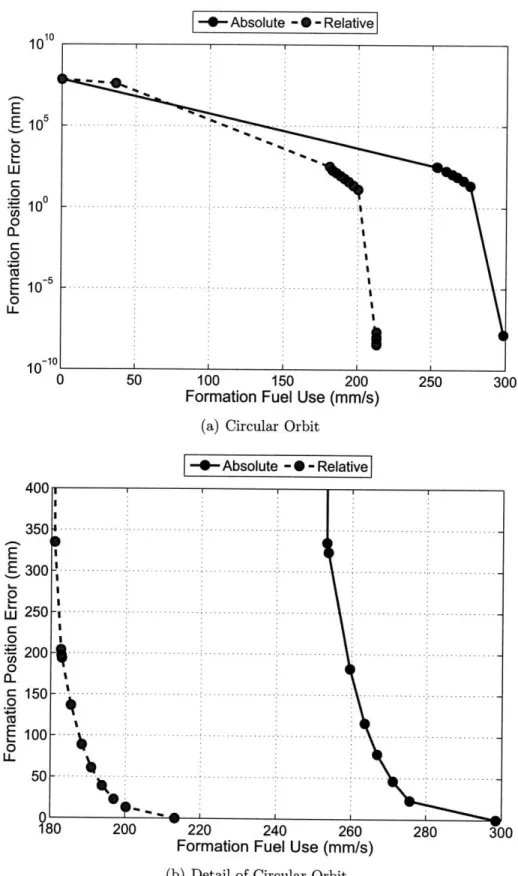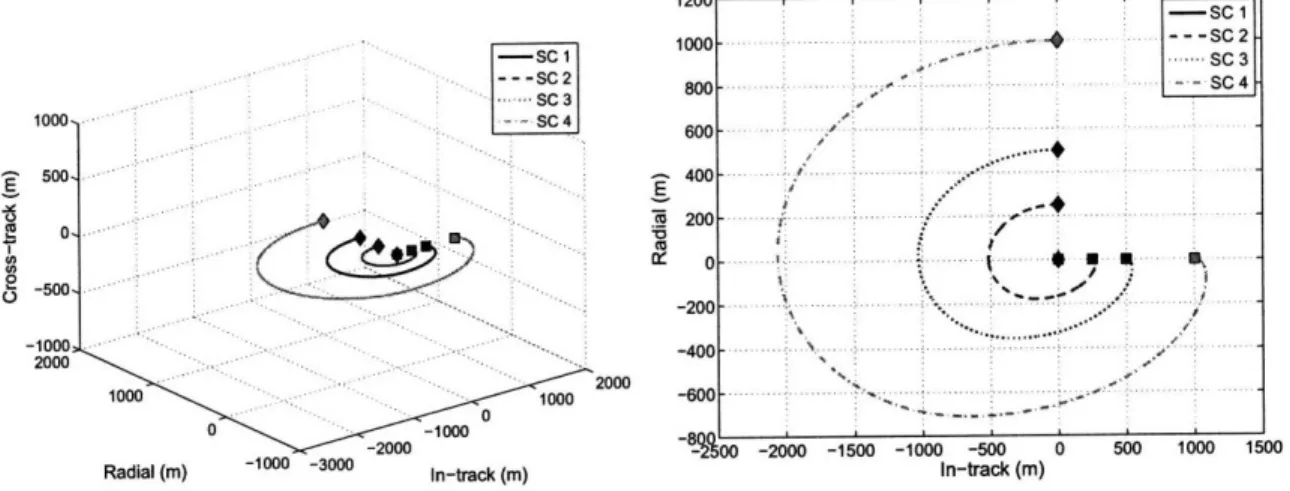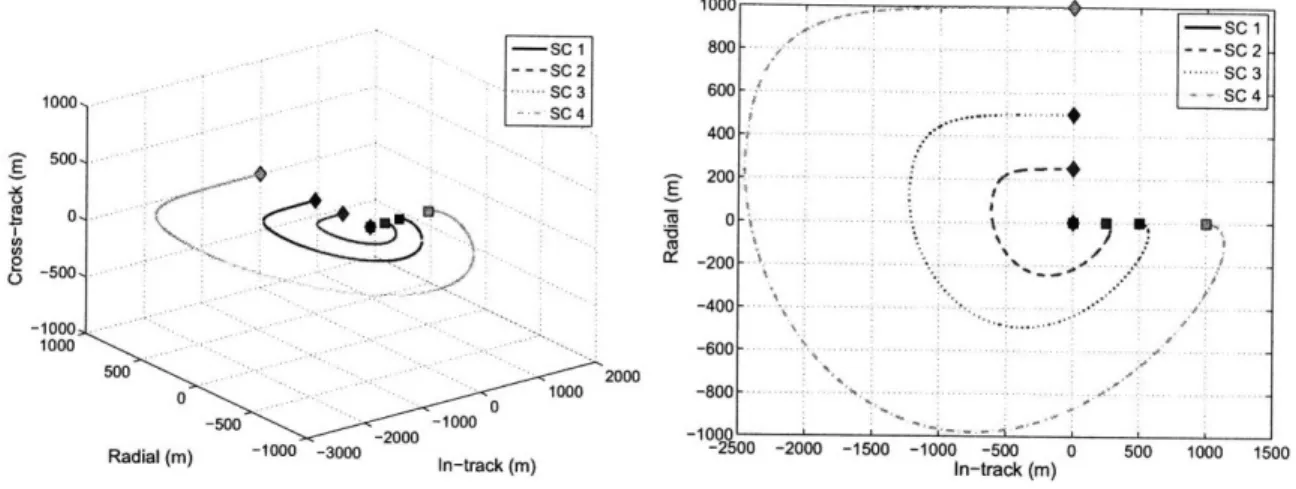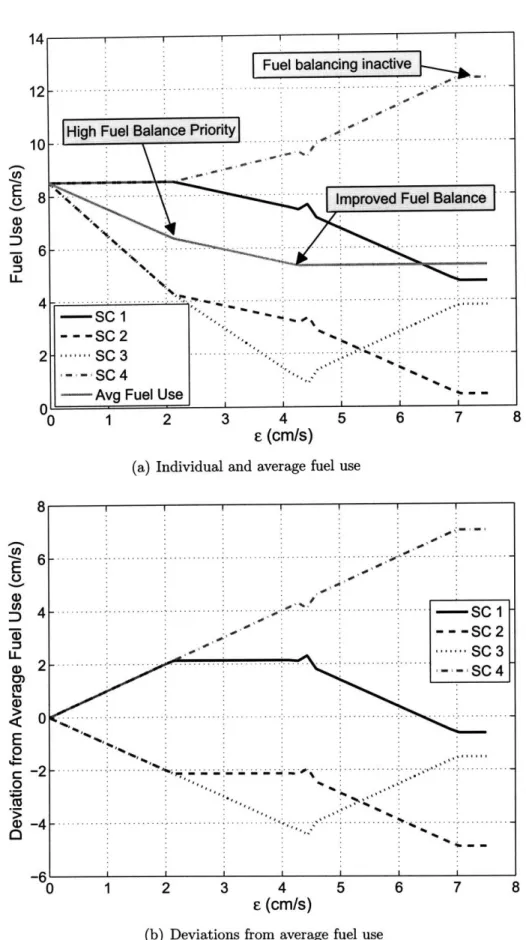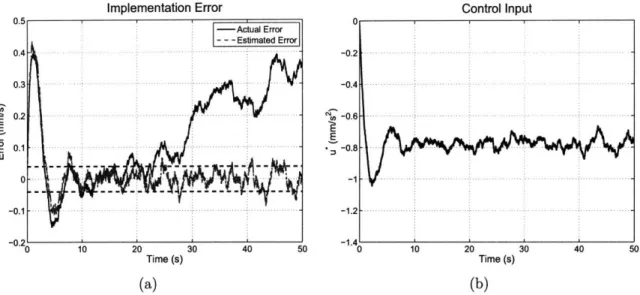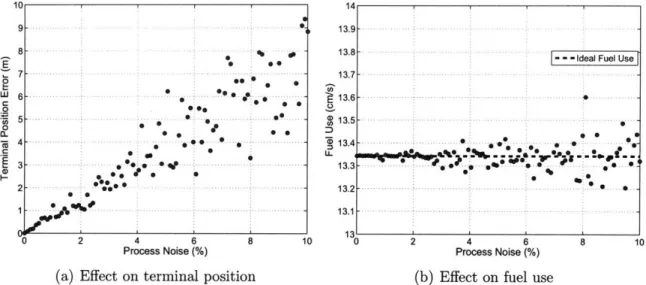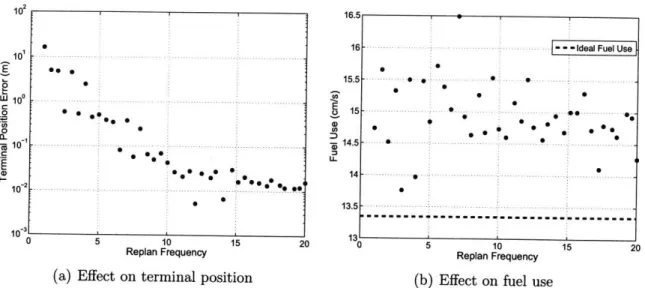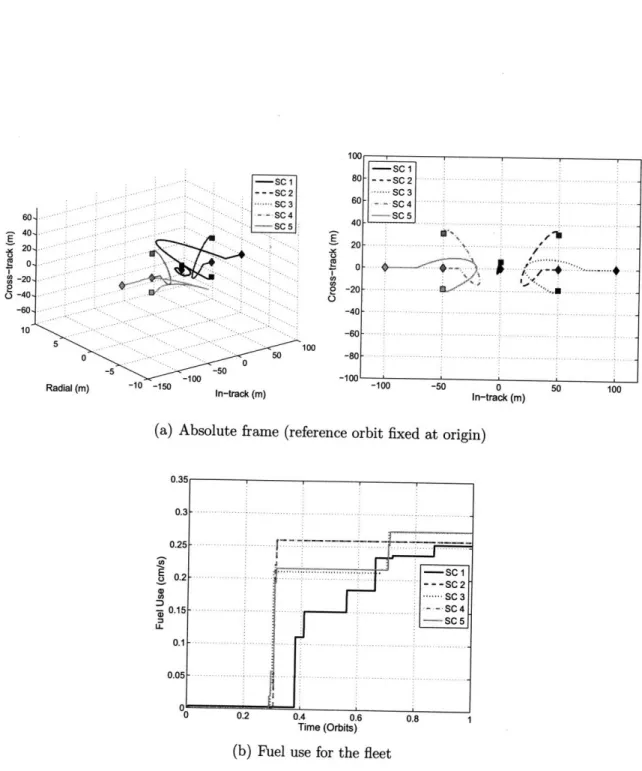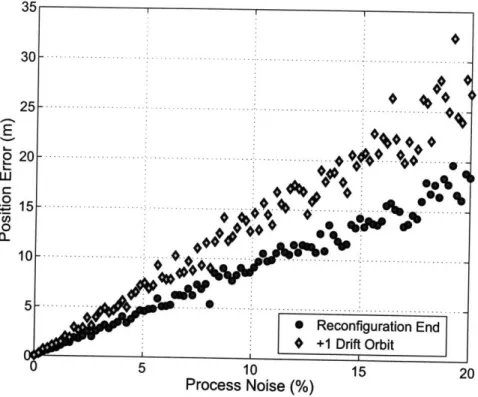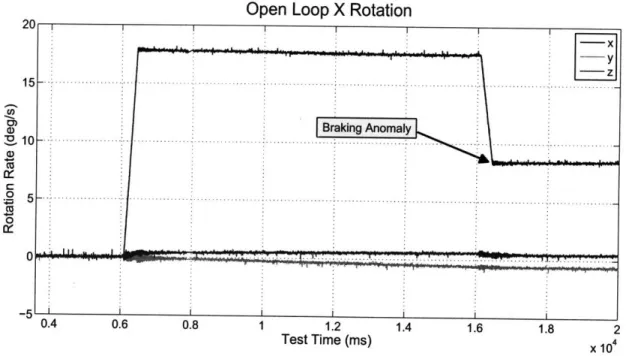Closed-loop Control of Spacecraft Formations with
Applications on SPHERES
by
Matthew M. Jeffrey
Bachelor of Science
Johns Hopkins University, 2006
Submitted to the Department of Aeronautics and Astronautics
in partial fulfillment of the requirements for the degree of
Master of Science in Aeronautics and Astronautics
at the
MASSACHUSETTS INSTITUTE OF TECHNOLOGY
June 2008
©
Matthew M. Jeffrey, MMVIII. All rights reserved.
The author hereby grants to MIT permission to reproduce and
distribute publicly paper and electronic copies of this thesis document
in whole or in part.
Author ...
Department of Aeronautics and Astronautics
May 23, 2008
Certified by...
...
Jonathan P. How
Professor of Aeronautics and Astronautics
.
, T~1esis Supervisor
Accepted by... ...
I .•.- ---.
...
L-avid L. Darmofal
M&SSACHUA', S IN T
OF TECHNOLOG
Associate Department Head
AUG 0 1 2008
Chair, Committee on Graduate Students
LIBRARIES
Closed-loop Control of Spacecraft Formations with
Applications on SPHERES
by
Matthew M. Jeffrey
Submitted to the Department of Aeronautics and Astronautics on May 23, 2008, in partial fulfillment of the
requirements for the degree of
Master of Science in Aeronautics and Astronautics
Abstract
Formation flying satellites offer potentially greater science returns and operational capabilities than attainable with a monolithic spacecraft. Successful control of a for-mation of spacecraft can be divided into two separate stages. The first stage creates a plan that meets a set of mission objectives, and the second stage implements the plan. Plans are specified as a sequence of AV commands executed at specific times during an orbit. This thesis presents an online method for generating fleet-wide plans, using convex optimization techniques, that satisfy multiple objectives. The approach allows for minimum and balanced fuel usage, can position spacecraft in arbitrary con-figurations, and favors low-maintenance orbits that do not drift apart. Additionally, the architecture is applicable not only to formation-keeping maneuvers, but also to formation reconfigurations. Various simulations demonstrate the importance of accu-rately implementing plans for formation flying as well as autonomous rendezvous and docking missions. Specifically, the relationships between process error, overall fuel use, and position error are studied. Theory is put into practice with the development of a new low-level, closed-loop thrust controller for the Synchronized Position Hold Engage and Reorient Experimental Satellites (SPHERES). The controller processes measurements from accelerometers and gyroscopes to monitor thruster performance in real-time. Experiments conducted on the International Space Station (ISS) validate the controller and establish a foundation for future enhancements to the underlying algorithm. Finally, data from a series of high-fidelity formation flying simulations is presented that confirms the analysis done elsewhere in the thesis. The multi-objective planner is used in a closed-loop control system that guides a formation of five space-craft through a hypothetical mission involving both reconfigurations and formation-keeping. Data from the simulations allows a straightforward, side by side comparison of the effects and relative importance of sensor error versus implementation error. Thesis Supervisor: Jonathan P. How
Acknowledgments
First I would like to thank my advisor, Prof. Jonathan How, for his guidance and keen insight, and for being patient whenever I was stuck on a problem or didn't know what step to take next. His ability to always ask the important questions was essential to completing this work. Thank you also to Kathryn Fischer for her administrative assistance, and for somehow providing a sense of order to everyone's hectic schedules. Thanks to Dr. Alvar Saenz-Otero and the entire SPHERES team (Amer, Brent, Chris, Christy, Jake, John and Swati) for letting an ACLer come onboard and feel welcome. Working with the satellites and participating in the ISS test sessions were highlights of my stay at MIT. A special thank you to Dr. Simon Nolet for his help with modifying the SPHERES estimator to work with my code. Thanks to my fellow labmates in the Aerospace Controls Lab for their creativity and intellectual energy, and thank you in particular to my officemate Georges Aoud6 for his encouragement and good humor during the more difficult times. A significant portion of this thesis extends research
by Dr. Louis Breger - without his time and unending willingness to help, it would
not have been possible. Thank you, Louis. Thanks also to Adam Wahab for being a great friend and providing some much needed entertainment throughout the past two years, and of course to Erin, for putting up with the long work hours and occasional bout of grumpiness!
Finally, the deepest thanks to my parents and sister Kerri for their love and support. Any small success I have enjoyed, I owe to their example that hard work, persistence and dedication are rewarded.
This work was supported by a National Defense Science and Engineering Graduate (NDSEG) Fellowship, administered by the American Society for Engineering Educa-tion (ASEE). Research also funded in part by the Mitsubishi Electric CorporaEduca-tion.
Contents
Abstract Acknowledgments Table of Contents List of Figures List of Tables 1 Introduction 1.1 Previous W ork ... 1.2 Thesis Overview ...2 Multi-Objective Planning for Spacecraft Formations
2.1 Formation Optimization ...
2.1.1 Separating the Initial and Desired States . . . .
2.1.2 Extension to the Multi-Vehicle Case . . . .
2.1.3 Relative Position Cost . . . .
2.2 Fuel Balancing ...
2.2.1 Equal Fuel Use ...
2.2.2 Equal Fuel Remaining . ...
2.2.3 Fuel W indow ...
2.3 Implementation Details . . . .
2.4 Formation Flying Test Cases . . . .
2.4.1 Position Cost Comparison . ...
2.4.2 Fuel Balancing Example . ...
2.5 Chapter Summary ... 25 27 28 30 32 35 37 39 40 41 44 44 52 55 : : : : : : : :
3 Implementation of AV Commands 3.1 Plan Implementation ...
3.1.1 Using Accelerometers to Improve AV Implementation
3.1.2 Discrete Example ...
3.2 Impact on Autonomous Rendezvous and Docking . . . .
3.3 Impact on Formation Reconfiguration . . . .
3.4 Chapter Summary ...
4 Development of a Closed-Loop Controller for SPHERES
4.1 SPHERES Background ...
4.1.1 Propulsion System Characterization . . . .
4.1.2 Instrumentation Details . . . .
4.1.3 Global Metrology ...
4.1.4 Current Control Scheme ...
4.2 Closed-Loop Inertial Control System . . . .
4.2.1 Filtering the Accelerometers . . . .
4.2.2 Effects of Spacecraft Spin on Accelerometer Readings
4.3 Recursive Least-Squares Estimator Algorithm . . . .
4.4 Results of SPHERES Tests ...
4.4.1 Translation Tests ...
4.4.2 Rotation Tests ...
4.5 Chapter Summary ... 5 Formation Flying Simulations
5.1 Simulation Architecture Overview 5.2 Simulation Scenarios ...
5.2.1 Baseline Scenario ...
5.2.2 Formation-Keeping Scenario
5.3 AV Implementation Error Model . .
5.4 Simulation Results ... 5.4.1 Baseline Scenario . . ... 5.4.2 Formation-Keeping Scenario 5.4.3 Simultaneous Implementation 5.5 Chapter Summary ... 6 Conclusions 6.1 Thesis Contributions ...
. . . .
... ... °...°.. . . .
. . . .
... . . . . . . . . . .. . . .
ad Sensor Error . . . . . . . . . . 57 .. . . 58 . . . . 60 ... . 65 . . . . 67 . . . . 72 ... . 73 77 78 79 80 80 81 84 86 90 94 98 98 100 101 107 107 110 110 112 112 116 116 119 120 121 139 ... . 1406.2 Recommendations for Future Work ... . . 142
A Digital Filter Overview 145
List of Figures
1-1 The Cassini Saturn Orbit Insertion . . . . 19
2-1 Comparison of offset cost and geometry cost . ... . 30
2-2 Relative position cost. ... ... . ... ... ... . 33
2-3 Hill's Frame (Local Vertical/Local Horizontal). .. . . . . .... 34
2-4 Effect of fuel use on position cost for a circular orbit. ... . 47
2-5 Effect of fuel use on position cost for an elliptical orbit. .... ... . 48
2-6 Reconfiguration maneuver for a circular orbit using absolute geometry constraints.. ... . 49
2-7 Reconfiguration maneuver for a circular orbit using relative position constraints.. ... . 49
2-8 Reconfiguration maneuver for an elliptical orbit using absolute geom-etry constraints. ... ... ... .... ... .. 50
2-9 Reconfiguration maneuver for an elliptical orbit using relative position constraints.. ... . 50
2-10 Fuel management as fuel balancing window size e is adjusted. . . 53
2-11 Reconfiguration maneuver for a circular orbit with fuel balancing (e = 2.15 cm /s) . . . ... ... ... . 55
3-1 Closed-loop control system for single thruster. ... .. . .. . . 61
3-2 Results of a discrete simulation of the closed-loop algorithm . ... . 66
3-3 The ideal rendezvous trajectory and plan... .. . . . 69
3-4 The effect of varying process noise on rendezvous performance. . . 71
3-5 The effect of replanning frequency on rendezvous performance. ... 72
3-6 Nominal five spacecraft in-track to passive aperture reconfiguration maneuver . ... .. .... .... ... 74
3-7 The effect of varying process noise on a formation reconfiguration. 75 4-1 A SPHERES satellite. .... ... ... .. 78
4-2 Thruster ringing effect that results from thruster actuation. .
4-3 Flowchart for a typical SPHERES control cycle . . . . .
4-4 Example of an open-loop braking anomaly from a test flight on the
ISS . . ... . . . ...
4-5 Filter characteristics for the IIR and FIR filters . . . . .
4-6 Step and impulse responses for the IIR and FIR filters . . . . .
4-7 Raw and filtered acceleration measurements for a burn in the +x
direction, taken from an experiment on the ISS . . . . .
4-8 A rotating spacecraft with an accelerometer mounted away from the
center of rotation. ...
4-9 Data from a SPHERES satellite performing a rotation about the +z
axis . . . . .
4-10 Recursive least-squares estimation of a rotation about the +z axis. 4-11 Recursive least-squares estimation of an acceleration in the +x
Direc-tion . . . . .
4-12 Results of a closed-loop translation burn on the air table as seen by
the algorithm and the global estimator . . . . .
4-13 Results of an open-loop translation burn on the air table as seen by
the algorithm and the global estimator . . . . .
4-14 Results of a closed-loop translation burn on the ISS as
algorithm and the global estimator . . . . .
4-15 Results of an open-loop translation burn on the ISS as
algorithm and the global estimator . . . . .
4-16 Results of a closed-loop rotation burn on the air table. 4-17 Results of an open-loop rotation burn on the air table. 4-18 Results of a closed-loop rotation burn on the ISS . 4-19 Results of an open-loop rotation burn on the ISS .
5-1 Spacecraft formations for the baseline simulation .
seen by the seen by the 81 82 85 87 88 90 91 93 97 97 102 102 103 103 104 104 105 105 ...111
5-2 Position error per orbit for the formations in the LEO baseline
simu-lation with implementation error . . . . .
5-3 Position error per orbit for the formations in the LEO baseline
simu-lation with sensor error. ...
5-4 Fuel use per orbit for the formations in the LEO simulations with
implementation error. ...
122
123 124
5-5 Fuel use per orbit for the formations in the LEO simulations with
sensor error. ... 125
5-6 Position error per orbit for the formations in the HEO simulations
with implementation error. ... 128
5-7 Position error per orbit for the formations in the HEO simulations
with sensor error. ... 129
5-8 Fuel use per orbit for the formations in the HEO simulations with
implementation error. ... 130
5-9 Fuel use per orbit for the formations in the HEO simulations with
sensor error. ... 131
5-10 Position error per orbit for the formation-keeping simulations. ... 134
5-11 Fuel use per orbit for the formation-keeping simulations. ... 134
5-12 The LEO baseline simulation with both implementation and sensor
error. ... 136
5-13 The formation-keeping simulation with both implementation and
sen-sor error. . .. . ... ... . . ... 137
List of Tables
4.1 Ideal force and torque axial directions for the SPHERES thrusters. 79
4.2 Test results summary of open-loop and closed-loop translation burns
on the air table. ... .102
4.3 Test results summary of open-loop and closed-loop translation burns
on the ISS. ... 103
4.4 Test results summary of open-loop and closed-loop rotation test burns
on the air table. ... .104
4.5 Test results summary of open-loop and closed-loop rotation test burns
on the ISS.. ... . 105
5.1 AV implementation error parameters for the simulations ... . 115
5.2 CDGPS navigation filter RMS accuracies . ... . . . . . 115
5.3 Baseline simulation results for the LEO orbit with implementation
er-ror . . . . . . .. . . .. .. . . . .. 126
5.4 Baseline simulation results for the LEO orbit with sensor error. . . . 127 5.5 Baseline simulation results for the HEO orbit with implementation
error.. . . . .. . . .. . 132
5.6 Baseline simulation results for the HEO orbit with sensor error. .... 133
5.7 Formation-keeping simulation results for the LEO orbit with
imple-mentation error. ... ... .... 135
5.8 Formation-keeping simulation results for the LEO orbit with sensor
Chapter 1
Introduction
In recent years, formation flying satellites have emerged as one of the most promising technologies in space flight. A fleet of smaller, cheaper, less sophisticated satellites working together can replace a single, monolithic satellite while at the same time increasing flexibility and redundancy. Such a fleet is ideal for a variety of science purposes, including distributed sensor systems, simultaneous observations, and inter-ferometry for Earth-observing or stellar telescopes. Moreover, there is the option of adding or replacing individual spacecraft during the mission to enhance the capabil-ities of the fleet or even create new ones. Although multi-spacecraft interferometers were suggested as early as the late 1970s [1], only the advances in estimation and control of the last several years have brought about the capability to realize such for-mations. As a result, there has been a surge in missions (both flown and proposed) utilizing formations of spacecraft.
NASA's Earth-Observing 1 successfully flew in formation with Landsat 7 in 2001, repeating the latter's ground track at a separation of about 450 km. The experiment was a demonstration of some of the basic technologies required for future formation flying missions [2]. In 2006, ST5, a formation of three micro-satellites and part of NASA's New Millennium Program, successfully provided simultaneous, multi-point measurements of the Earth's magnetic field [3]. The A-Train constellation, an inter-national collaboration between NASA and CNES, currently consists of five satellites with plans to add two more. The satellites fly in an along-track separation within
sev-eral minutes of each other and study clouds and precipitation [4]. Each spacecraft in the A-Train has its own instrumentation, but by combining the diverse measurements,
scientists are learning new things about cloud formations.
While these missions have been impressive successes, space-based interferometry promises even greater science returns. Agencies worldwide are currently planning mis-sions like Darwin [5], the Terrestrial Planet Finder (TPF) [6], the Laser Interferome-ter Space Antenna (LISA) [7], the X-ray Evolving Universe Spectroscopy (XEUS) [8], and the Micro-Arcsecond X-ray Imaging Mission (MAXIM) [9), to harness this poten-tial. LISA will search for low-frequency gravitational radiation characteristic of black holes, while Darwin and TPF scan the stars for Earth-like planets that might support life. These missions utilize two, three or even eight spacecraft and present challenges more difficult than those that have thus far been met on orbit. For that reason, a separate crop of formation flying demonstration missions seeks to test and validate the algorithms required for maintaining strict inter-spacecraft geometry requirements. PROBA 3, by ESA [10] and PRISMA [11], from the Swedish Space Corporation, are a pair of two satellite missions that will test formation flying sensing and control technologies.
Autonomous rendezvous and docking is another research area that generates a lot of interest. The Russians have been docking autonomously with their Progress and Soyuz spacecraft since Mir [12], and in 1998, the Japanese ETS-VII mission performed an autonomous docking between two unmanned spacecraft [13]. Most re-cently, ESA's Jules Verne [14], the first of five planned automated transfer vehicles (ATVs), successfully docked with the International Space Station (ISS) after perform-ing a series of checkout and demo maneuvers. This type of vehicle, with autonomous rendezvous and docking capabilities, plays an important role in NASA's post-shuttle
plans for the ISS (e.g., the Commercial Orbital Transportation Services, or COTS,
program [15]). Despite these successes, it would be premature to call AR&D routine, as recent missions have shown that serious failures can occur. In 2005, DART [16] experienced navigational difficulties that caused it to fly into directly into its target
Fig. 1-1: Artist's impression of the Cassini SOI (Courtesy NASA/JPL-Caltech).
2007, the Orbital Express mission successfully demonstrated many of the technologies first attempted with DART [18].
Formation flying and rendezvous and docking missions share a common need for accurate sensing and implementation of AV commands. This thesis studies the ef-fects of inaccurate AV implementation on rendezvous scenarios as well as formation flying missions. Specifically, it explores the use of accelerometers to improve the AV
implementation.
1.1
Previous Work
Numerous authors have proposed control algorithms for formation flying missions [1]. Many of these are based on the Hill-Clohessy-Wiltshire (HCW) equations [19, 20] for circular orbits, or Lawden's time-varying equations [21] for elliptical orbits. These descriptions are convenient for computing the relative motion of satellites; the HCW equations are linear time-invariant, and Lawden's equations are linear time-varying. They have also been modified to include the dominant effects of the Earth's
oblate-ness [22]. Finally, both of these dynamics models have been used in PD [23], LMI [24], LQR, nonlinear [25], impulsive [26, 27], and model predictive control (MPC) [28] con-trol designs.
Unfortunately, these approaches use Cartesian coordinates in an LVLH frame that limits their accuracy to formations with short baselines, typically less than 1 km. Breger and How showed in [29] that by using Gauss's variational equations (GVEs), where the dynamics are expressed in relative orbital elements, formations with much longer baselines, such as MMS [30], can be successfully controlled using MPC. The longer baselines are possible because the GVEs describe satellite motion in a curvi-linear frame, where long curvi-linear distances are described by small perturbations in the orbital elements [31]. Breger's MPC uses linear programs (LPs) [32] and a state
transition matrix incorporating J2 effects developed by Gim [33]. Elsewhere in the
lit-erature, GVEs have been used in other control schemes, such as continuous-thrust [34] and impulsive controllers [26, 35, 36].
This thesis builds on the previous research on MPC control of formations [23, 28, 29, 37-41]. Linear programs are convenient because they are fast and reliable, and can incorporate realistic constraints (actuator bounds, thrusting restrictions, position error boxes) that are difficult to model with other control techniques [28]. The idea was proposed in [23] as a possible control approach for the ORION formation flying demonstration mission that was being planned at that time [42]. The concepts were significantly expanded in [28] and [39], where a number of realistic constraints were modeled inside the LP framework. With any formation, a primary goal will be to prevent the spacecraft from drifting apart by initializing them to invariant orbits.
References [43, 44] present approaches for achieving J2 invariance based on
solv-ing necessary conditions for partial invariance of the mean orbital elements. These methods minimize secular drift in the mean orbital elements, but contain unspecified degrees of freedom. Work by Breger and How [29, 41] introduced an optimization-based approach for finding invariant orbits that can minimize more general definitions of drift (e.g., Cartesian separation, osculating states) over arbitrary time frames while minimizing fuel and considering performance objectives. This approach yields results
that can be used online to optimize and re-optimize initial conditions for Earth-orbiting formation flying missions that require drift to be minimized, but that also have particular geometry requirements on separation distance or shape.
Sensor noise has long been known as a driver of system performance for spacecraft formations [37, 45]. Tillerson investigated the impact of sensing noise for formations in circular orbits in [39]. His work was based on, at that time, a state-of-the-art CDGPS navigation filter developed by Busse [46] that provided relative position measurements with an accuracy of about 1 cm and relative velocity measurements within 0.5 mm/s. Advances in filter design and technology place current estimates of attainable ac-curacy at 1.5 mm for relative position, and 5 pm/s for relative velocity [47]. The drastic reduction in sensing uncertainty has allowed other sources of error to limit performance, specifically the thruster system [36]. The implementation of AV com-mands is an essential function of any spacecraft, whether it is part of a formation or not. Inertial measurement units (IMUs), fairly standard on modern spacecraft, usu-ally consist of gyroscopes and accelerometers and assist in this function. The ATV that services the ISS uses three two-axis accelerometers and four two-axis gyrome-ters [48]. The Cassini spacecraft used accelerometer measurements to perform the mission-critical Saturn Orbit Insertion [49, 50]. Likewise, the Deep Impact mission to "rendezvous" with the comet Tempel I relied on accelerometer measurements to autonomously correct its final approach trajectory [51]. The trend will continue into the foreseeable future, with one example being the control system for the upcom-ing Terrestrial Planet Finder. TPF will use accelerometers and gyros to accurately implement AV commands [52].
1.2
Thesis Overview
Chapter 2 extends the GVE-based MPC in [29] from a single spacecraft to a fleet-wide optimization, and a series of new constraints and performance objectives are intro-duced that expand the controller's capabilities. The initial state of the formation is separated from the desired state so that the MPC can be used for reconfiguration
problems in addition to formation-keeping problems. Additionally, rather than spec-ifying all spacecraft positions with respect to a reference orbit, a new way to specify relative positions, based on the leader-follower strategy, is derived. The issue of bal-ancing fuel use is also addressed, and a series of constraints designed to encourage this desirable behavior are presented. Example plans for spacecraft formations are
generated and analyzed to demonstrate the performance of the controller.
Maneuver plans designed by the MPC in Chapter 2 are output as a list of AV commands that must be executed at specific times. Chapter 3 tackles the problem of actually implementing the AV commands that make up the plans. Two approaches are considered: an open-loop system where thrust durations are calculated from a thruster model, and a closed-loop system that monitors the performance of the burn in real-time and uses feedback to determine when to terminate it. The dangers of the open-loop strategy are discussed, and the closed-loop system using accelerometers is proposed as a way to increase burn accuracy. After developing the theory for the closed-loop system, the two approaches are compared side by side through a series of simulations. The performance degradation that results when plans are poorly implemented is quantified for a rendezvous scenario (in LEO with an orbit similar to that of the ISS). Two methods are identified for improving the performance for such a mission; more accurate plan implementation, or replanning. The performance tradeoffs for each are explored with an emphasis on the advantages of better plan implementation. After the rendezvous scenario, the fleet-wide planner introduced in Chapter 2 is revisited to confirm the importance of accurately following its plans. The ideas of Chapter 3 are put into practice through the development of a new low-level controller for the SPHERES satellites in Chapter 4. This chapter walks through the design of the control system and documents how various problems encountered during the process were solved. Two different algorithms for measuring thruster performance in real-time during a burn are proposed. The first utilizes low-pass digital filters to process accelerometer measurements and integrate them directly. Test results from experiments on a 2D air table as well as on orbit testing from the ISS then form the basis for an improved algorithm using least-squares estimation
techniques.
Formation planning and accurate AV implementation concepts are unified in Chapter 5 through a series of high-fidelity, realistic formation flying simulations. Based on performance requirements that are representative of actual missions, the planner of Chapter 2 is integrated with a commercial orbit propagator to control a fleet of spacecraft over dozens of orbits. Plans for reconfigurations and formation-keeping are both generated and executed, and data on the impact of poor AV imple-mentation is analyzed in terms of fuel use and position error. This analysis is repeated for perfect implementation with varying levels of sensor error, and comparisons are made between the two types of error. The simulations underscore the benefits of improving the accuracy of AV implementation.
Finally, Chapter 6 closes the thesis with a recap of the important findings, and concludes with suggestions for future work.
Chapter 2
Multi-Objective Planning for
Spacecraft Formations
Spacecraft formation flying is expected to be an enabling technology for many future missions [53]. Successful control planning for a formation must consider a range of competing performance objectives and find acceptable compromises that meet mis-sion requirements. Through collaboration and cooperation, the spacecraft in a for-mation act as a single system that offers better performance than is attainable with a monolithic spacecraft. Performance enhancements include superior science observa-tions with space-based interferometry, cheaper launch costs spread out over smaller, lighter vehicles, or more versatility with a fractionated spacecraft design. The plan-ning tasks for a formation can be divided into two classes [39]: formation-keeping and formation reconfiguration. In formation-keeping, the spacecraft are already in their desired configuration, and positions and velocities are simply maintained by applying control to counteract disturbances (which manifest as drift). In formation reconfiguration, the desired positions and velocities change, and trajectories must be generated to relocate the spacecraft accordingly. Both classes are important and will be addressed here.
Formation flying missions frequently have several different operating configura-tions. For example, the Magnetospheric Multiscale Mission (MMS) will consist of four spacecraft in a tetrahedral formation studying plasma dynamics in the Earth's
magnetosphere [30, 54], but the separation distance between spacecraft will vary from 10 km to 1000 km depending on the phenomena currently being observed. When re-configuring, it is critically important both to conserve fuel during the maneuver and to maneuver to a state that will, over time, conserve fuel. The selection of states with these properties is called an initial condition (IC) problem, the specifications of which will depend upon the unique requirements of a particular mission. However, in any spacecraft formation, a primary goal will be to prevent the vehicles from drift-ing apart, since that will typically end the mission. If the spacecraft in a formation tend to drift apart, then periodic maintenance maneuvers will be required during formation-keeping to restore the formation. Initial conditions are called invariant if they eliminate drift, thereby allowing spacecraft to maintain their relative orbits without expending fuel. Invariant orbits simplify the formation-keeping process. Two expected sources of relative drift for an Earth-orbiting formation are mismatched
semimajor axes [551 and J2 disturbances. Finally, for space-based interferometers,
such as TPF [61, MAXIM [9], or LISA [7], loss of control of one spacecraft cripples
the science output for the entire formation. Since a spacecraft would become un-controllable if its fuel supply were exhausted, fuel use should be balanced across the formation.
This chapter presents an online method that meets the challenges outlined above; it approaches planning from a fleet-wide perspective and optimizes fuel usage, fuel balancing, formation geometry, and drift. Online methods are desirable because they help minimize the delay between the detection of disturbances and their correction, enabling more precise formation flying. The method is an extension of the model predictive controller in [29], with more flexible performance objectives, but its roots can be traced even further back to ideas in [23, 28, 40]. Separation of the desired geometry from the starting geometry enables reconfiguration maneuvers in addition to formation-keeping. Furthermore, the optimization problem is expanded to include all spacecraft in the formation, permitting the introduction of relative geometry
con-straints - a prerequisite for implementing the popular leader-follower approach. The
sin-gle spacecraft at a time, but for the entire formation simultaneously, enabling true formation flying via extensive cooperation [38].
2.1
Formation Optimization
Reference [41] derived a single spacecraft IC optimization based on Gauss' Variational
Equations (the GVEs derived in [56]) modified to include the effects of J2. The GVEs
describe the motion of an orbit (expressed in absolute osculating elements) subject to perturbations. A reference orbit is taken as
ere=[a e i
Q
w M] (2.1)where a is the semimajor axis, e is the eccentricity, i is the inclination, Q is the right
ascension of the ascending node, w is the argument of perigee, and M is the mean
anomaly. The relative position of a spacecraft (with absolute state e) is defined with respect to the reference orbit as
Se = e - eref (2.2)
Using the GVEs and (2.2), Breger [41] derives the optimization
C*
=
min
{QduIWd(Q*l - I)(@I 06e(to)
+LU)II
+
QxIIWxFUII
+
QIIUll}
(2.3)where C* is the optimal cost, U is a column vector of control inputs, 6e is a differential column vector of osculating orbital elements, P is a discrete convolution matrix, and the weighting matrices Wd and Wx specify the form of the penalties for drift and
formation geometry, respectively. The scalar weights Qd, Qz, and Q, determine the
penalties on drifting, formation geometry, and fuel use. The state transition matrix, CIn, propagates the differential state vector from time t, to time t,+1. Additionally,
to is the time at the start of the optimization, t1 is the time at the end of the
one orbit). All norms in these optimizations are one-norms. The control sequence
U(r), r E [to, tl] is of the form
U=[
U uT
where n is the number of steps in the plan. Moreover, each entry uk is a three-element
vector
uk
ukx
u[
k, kz
(2.5)
where the subscripts x, y, and z denote the radial, in-track, and cross-track directions in the local vertical/local horizontal (LVLH) frame. Since control is not allowed during the drift period, a good solution to the optimization problem must balance the desire
to achieve low-drift initial conditions at ti with the desire to preserve formation
geometry and conserve fuel. The individual elements of the cost function (2.3) are
written as Cd (drift), Cx (geometry), and Cu (fuel).
2.1.1
Separating the Initial and Desired States
The geometry cost in (2.3) is given by
C =
Qx11Wxl'UII
(2.6)Inspection of (2.6) shows that the cost will increase with the input effect of the
control, PU. In other words, if the applied control causes the spacecraft to move to
a new position, it will incur a positive cost. The only way Cx is zero is if the overall effect of U is to not move the spacecraft at all. Therefore, the optimization presented in Ref. [41] tacitly assumes that the initial location of the spacecraft is the desired location. This limits its usefulness to the formation-keeping case, where the formation is already initialized and the main concern is to find a minimum-drift orbit; it does not allow for a formation to be reconfigured.
This limitation can be overcome by modifying the optimization in (2.3) to separate the initial state, 6e(to), from the desired state. The vector Sed(tl) is introduced as
the desired state at the end of the initialization maneuver, and the difference between the desired state and the actual state at tl is penalized
c,
=
IIWX(Jed(tl)
-Je(ti))ll
(2.7)
Substituting Se(ti) = 5*o06e(to) + fU gives a new geometry cost
Cx
=
IIWx(Jed(te
)
- ~D
06e(to)
-
FU)II
(2.8)
making the altered optimization
C* = min
{QdIJWd(
*1 -I)(D
065e(to)
+IU)II
+ (2.9)QxlIWx(ead(tl)
-
4*DO6e(to) -
LvU)ll
+
QUIIUII}
The independence of the starting position, 6e(to), from the desired position, Sed(tl), provides the capability to design trajectories that deploy the spacecraft to some new orbit, while still minimizing drift and fuel use. This expands the capability of the controller to reconfiguration problems. Functionality has only been added, not lost; if the desired position at tl is equal to the open-loop propagation
5ed(tl) = j*oDe(to) (2.10)
then the cost (2.9) is equivalent to (2.3). The new formulation is also useful for implementing the optimization as a closed-loop controller, because in practice, the spacecraft will never exactly be in their desired position, due to thruster and sensor error.
Figure 2-1(a) illustrates the previous geometry cost associated with (2.3) and is adapted from [57]. The initial position of the spacecraft at to is marked by a circle, as well as the open-loop (no maneuver) position at tl and the actual position at tl (which depends on the control plan). The dashed line indicates the quantity that is penalized. Henceforth, it is called the "offset" cost since it is proportional to the
Control
with I t, Geometry penalty
maneuver t, no t1 desired position t mnno to maneuver
;
_
II Ia I•Uv I 'ref ref(a) Offset Cost (b) Geometry Cost
Figure 2-1: Comparison of offset cost and geometry cost.
magnitude of the offset caused by the control input. The offset cost is not used from this point on, and should not be confused with the new "geometry" cost, described by the modifications in (2.9) and reflected in Figure 2-1(b). The key difference is the new desired state at tl, and the cost is now proportional to the spacecraft's distance from this desired state. The open-loop propagation to tl no longer plays a role in the cost assessment, and is irrelevant.
2.1.2
Extension to the Multi-Vehicle Case
Previously, using the general strategy presented here for formation flight consisted of combining separate solutions to the single spacecraft optimization in (2.3) [41). While this has the advantage of keeping the problem size small (fewer decision variables and constraints), it is unlikely that implementing independent solutions for each spacecraft will result in an optimal overall plan. For example, sometimes it may be advantageous
for one spacecraft to sacrifice individual optimality for global optimality (e.g., one
spacecraft uses more fuel so that all of the others can use less). To extend the formulation to the multi-vehicle case, introduce the formation state J6, a desired
Offset
oM
m~~~l I·rclrh __
formation state 56 d, and a formation plan U as
[
...
T eT=
[
UT
U
.-. UN
] T(2.11)
where N is the number of spacecraft in the formation, 6ei is the state of the ith
spacecraft in the formation, Jed, is the desired state of the ith spacecraft, and Uj is a vector of control inputs for the ith spacecraft. Similarly, define the formation-wide propagation matrix from ti to tj+l as ýi and a formation-wide discrete convolution matrix f as •*Di 0 ... 0 0 ~*i 0 0 '0 . 0 0 ... 0 o4i and = F 0 .-. 0
0
o
0
o ... o
*
(2.12)Finally, the multi-spacecraft weighting matrices are
Wd 0 ... 0
o
Wd
0
* 0 ". 0o ...
0
Wd
and I =S0
...
0
o ...
0
W,
Combining (2.11)-(2.12) yields the state of the entire formation at time tl given the state at to
5e(t1) = oS6e(to) + £' (2.14)
The propagation in (2.14) and the formation weighting matrices in (2.13) can be combined to form a full formation initialization optimization based on (2.9)
C* = rin {Qdllld((l - I)(Poi6(to) +
FIU)II
+ (2.15)U
QxIIWx(Jbd(tl) - Io6A(to) -
FU)II
+
QuiIUII}
Wd (2.13)
Solving (2.15) yields the optimal formation-wide initialization cost, 0*, and produces a set of optimized control inputs for each spacecraft in the formation. These control inputs, in turn, specify the trajectories each spacecraft should follow to achieve the initial conditions. In contrast to the analytic methods for finding invariant orbits that are available in the literature, this new approach to finding formation ICs can be used to minimize drift globally across an entire formation of spacecraft.
2.1.3
Relative Position Cost
The primary reason for converting to a formation-wide optimization is to provide a method that can handle coupling between the spacecraft. Coupling occurs in the tra-ditional leader-follower architecture, where one spacecraft is designated the "leader", and the others in the formation are its "followers". Position and velocity constraints for the followers are specified relative to the leader. If the leader spacecraft executes a maneuver, then the other spacecraft in the formation are affected; hence, there is coupling. Simple examples of a leader-follower are EO-1 [2], which followed one minute behind the ground track of Landsat-7, and XEUS [8], where the X-ray science instrument is split between two spacecraft. Moreover, the geometry requirements for space-based interferometers such as TPF [58] and Darwin [5] are typically specified in the relative frame. The cost function (2.15) only penalizes geometry deviations from a static reference orbit; penalizing relative geometry requires the trajectories to be optimized jointly because a variation in the trajectory of one spacecraft will require an adjustment in the trajectory of the other. For leader-follower missions and interferometers, it might be advantageous for the formation to stray some distance away from the reference orbit, as long as strict relative separations are maintained. Allowing this flexibility can result in reconfigurations that save fuel or reduce drift. Relative position constraints address this issue.
Figure 2-2 illustrates the relative position cost. The new idea is that the origin of the coordinate system is fixed to a leader spacecraft, not a reference orbit. Any spacecraft in the formation can be selected as the leader, and its differential state at
IN
Rel. Pos. penalty
AMen(t,)
desired
;lative
position
Figure 2-2: Relative position cost.
to is See(to). The relative position of the ith spacecraft is then given by
A6ei(t) = 6ei(t) - s6e(t) (2.16)
In this notation, the A signifies a relative position. Using (2.16) and the single-spacecraft equivalent of (2.14) yields the desired relative position at tl
A6ed,(tl) = D0o(6ei(to) - 6ee(to)) + F(Ui - Ue) (2.17)
where Ue is the control plan of the leader. To penalize the deviation from the desired
relative position at tl, AJdd(tl) and AS6(t 1) are constructed in the same manner as
(2.11) and a new term, 0 r, is appended to the cost function:
Cr
=
Qr
IIWr
(ASed(tl) - As (t1))ll
(2.18) In this cost, Q, is a scalar weight specifying the penalty on relative position error, andWr is a weighting matrix specifying the form of this error. Until now, geometry costs
have been assessed in differential osculating orbital elements (2.2). As shown in [41], choosing Wr as the transformation matrix from differential osculating orbital elements to the LVLH frame allows the geometry to be penalized in a Cartesian sense (recti-linear distances as opposed to the curvi(recti-linear distances for osculating elements). The
Z
LCX
/
/ /
/
Figure 2-3: Hill's Frame (Local Vertical/Local Horizontal).
LVLH frame is more intuitive for visualizing formations and assessing performance because distances are specified in meters rather than orbital elements. Figure 2-3 depicts the LVLH frame for an orbiting satellite. The transformation matrix M(e(t)) is defined in Ref. [59] such that
Mx =6eos - x = M-16eos (2.19)
and it rotates
x=[x y z y
i
]T (2.20)from the LVLH frame centered on the reference orbit to differential osculating ele-ments.
Although the form of Cr is similar to Cx in (2.15), the matrices in (2.12) must
be slightly modified to incorporate the new coupling effects. Subtract Di from the
column of the formation propagation matrix corresponding to the leader, and subtract F from that same column in the discrete convolution matrix for the full formation.
formation matrices, denoted by the subscript r, then become 0 0 .. 0 - Di Di 0
S
0 ". 0 D-Di ... 0 Di and r = 0 0 .-. 0-17 F
0
0
o 0f
L ·The cancelations in the first row results in a row of zeros that automatically discards the position constraint of the leader relative to itself. In fact, the row can be omitted
entirely; the net result is an additional N - 1 constraints. The new cost, 0 r, is
adjoined to the global optimization, yielding the cost function
0'* = min{QdllWd((Il - I)(JIo6e(to) + FU)l) + (2.22)
U
Q••Wx,(6sd(t1)
-
4oSe(to) -
7U)II
+
Qr•
TIVr(TAJ
(tl)
-
Iro6,(to) -
frlU)l
+
Qju|u|}
2.2
Fuel Balancing
When a satellite in a formation runs out of fuel, there are several possible responses. If the formation is fully redundant, then perhaps there is not any discernable effect on operations and no action is required. Otherwise, the formation might continue to function in a reduced capacity. Another option is to replace the satellite at some cost. In the worst case, the satellite that runs out of fuel is irreplaceable or mission critical, and the mission ends. Regardless, it is beneficial to consider each satellite's remaining fuel supply when planning maneuvers and trajectories. For many missions it is desirable that each satellite in the formation expends fuel at roughly the same rate to avoid the aforementioned scenarios. For example, suppose a formation consists of two interdependent satellites (Sat A and Sat B) with an initial in-track separation of 1 km. They are tasked with a mission that requires them to reconfigure to 100 m relative separation. If both satellites begin the maneuver with the same amount of
fuel, the best solution is for each to move 450 m towards the other, and meet in the middle. However, if Sat A has more fuel than Sat B, then Sat A should travel further than Sat B. This will help balance the fuel between the satellites and prolong the mission life. Sat A sacrifices local optimality in favor of global optimality; it uses more of its own fuel, but improves the overall fuel management of the formation.
In practice, questions of fuel balancing are likely to be much more complex, but the ideas remain the same. If the formation is specified with respect to a reference orbit, then care must be taken that the reference orbit accurately describes the mean motion of the fleet. Because it is a theoretical construct, the reference orbit is not subjected to the disturbances experienced by the actual spacecraft. If these disturbances are inaccurately modeled when propagating the reference orbit, then fuel will be wasted trying to track a poor description of the formation's motion [38]. The traditional leader-follower approach eliminates this shortcoming by using the leader spacecraft as the reference point. However, by definition, the leader spacecraft has no state error and will use less fuel than the followers. Beard considered the problem of rotating a formation of spacecraft in free space [60], noting that if the formation rotates about a spacecraft, then that spacecraft will consume much less fuel than the others. Therefore, the starting fuel distribution should determine the optimal point of rotation. Later, Rahmani, Mesbahi, and Hadaegh considered the problem of balancing energy consumption for formations of two and three spacecraft [61]. Their approach was tested on problems in free space as well as for circular orbits
(using Hill's equations), but the control solutions involve continuous thrust, which may be undesirable. Vadali, Vaddi and Alfriend also derived a continuous controller for maintaining a formation in a circular orbit, but using Hill's equations modified to include J2 [62]. Each of these approaches are valid only for specific classes of orbits. Unfortunately, the minimization of fuel for one spacecraft and the balancing of fuel use across a formation are in general, competing objectives. The virtual structure attempts to solve this problem by treating the formation as a single entity, allowing it to evolve in a given direction as a whole [63]. Tillerson, Breger, and How derive the
space-craft are specified. It is computed from the relative states and weighted according to fuel remaining. This biases the virtual center towards spacecraft with less fuel, and yields improved fuel balancing during formation-keeping for sparse aperture forma-tions. The virtual center is computed strictly from the current formation geometry and does not depend on the dynamics of the orbit.
The following sections propose several ways to introduce fuel balancing constraints into the planner, presented in order of increasing generality. Used in conjunction with relative position constraints, it shares some similarities to the virtual center approach for formation-keeping. However, the need for an explicit calculation of the virtual center is eliminated; the optimal point will be found by the optimization itself. Moreover, since the fuel balancing constraints are implemented along with all of the other constraints (minimum fuel, position, and drift), the dynamics of the system are embedded (contrary to the virtual center approach). Overall, this allows fuel balancing to also be used for formation reconfigurations, and it is not limited to circular orbits.
2.2.1
Equal Fuel Use
One method for equalizing fuel use across the fleet is to penalize the deviation of each spacecraft's fuel use from the average. Fuel consumed is equivalent to the one-norm of the control inputs for each spacecraft. For a plan with n steps, the fuel use of the
ith spacecraft is given by:
n
Slu,jII
(2.23)
j=1
where u is defined as in (2.5) and the second subscript, j, corresponds to a specific
input step in the plan. For a formation of N spacecraft, the average fuel use is then
1 N n
N
E
Iluijll
(2.24)
The equal fuel use fuel-balancing cost associated with the kth spacecraft is the norm of the difference between its fuel use (2.23) and that of the average (2.24)
k,-fuse
=-
uj
(2.25)
j=1
i=1 j=1
which can be simplified by defining vi =
f
uill and Vi = Ui| so thatV=
[
U
I-
|U2 1 ...iUN|]
T (2.26)With these substitutions, (2.25) is equivalent to
k, fs = Vk - V (2.27)
i=l
The total cost for unbalanced fuel use can be written as a matrix equation in a manner similar to the previously developed relative position cost. If the weighting matrix Wf is Wf = (1-) J 1 _ N 1 N1 N N) 1 N N 1 1 1 N '" N N
(2.28)
then (2.26) and (2.28) lead to the final equal fuel use cost
Cfse =
WfV
(2.29)Although (2.29) contains the norm of a function of the norm of U, it is still convex and is therefore a valid linear programming constraint. In practice, it is not very difficult to add this constraint to (2.22), as V is already available as part of the minimum fuel
2.2.2
Equal Fuel Remaining
For situations when the spacecraft in the formation all start with the same amount of fuel, it might make sense to consider the approach in the previous section. However, it is more likely that each spacecraft in the formation has a different amount of fuel remaining at the start of the maneuver. In that case, it is preferable for the spacecraft starting with more fuel to use more than those starting with less fuel. This can be handled simply by keeping track of the fuel remaining for each spacecraft. The fuel remaining in the formation prior to planning is written as a vector
- =
f- f-.
f]1
(2.30)
Here, fi- is the fuel remaining for the ith spacecraft before the maneuver, and the
units are the same as for U(. The formation is penalized for having spacecraft with fuel remaining after the maneuver that deviates from the average. The cost for a
single spacecraft is then
ci,
= K-
-
-Vk)
(2.31)
k=1
Similar to (2.29), the total formation cost can be written in matrix form as
Cfem = 1Wf(F - V) (2.32)
When the linear program is formed, a series of constraints are added to guarantee that the fuel used by each spacecraft does not exceed the fuel available.
f - vi v 0 Vi (2.33)
The cost in (2.32) is actually a generalization of (2.29), and rewriting it yields
If the initial fuel of each spacecraft is the same (f- = f- = ... =
fN),
then from the structure of WfWF-=
[
0
...
(2.35)
and (2.34) reduces to (2.29). A weakness of this formulation is that even a small variation in remaining fuel will be penalized, and over the short term, it is unrealistic to expect the fuel usage of each spacecraft in the formation to be identical. There will be slightly different disturbances acting on each, and the initial state errors will also vary, requiring different levels of control. Balanced fuel use is really better described as a long term objective; some local variation is acceptable, but trends should be avoided. The next approach better captures this behavior.
2.2.3
Fuel Window
The final method of fuel balancing considered here is based on the concept of error boxes from [28]. In the fuel window approach, the fuel level for each spacecraft is allowed to deviate from the average within some acceptable range (window). As long as the fuel remaining for each spacecraft remains within the window, no cost penalty is assessed. If the window is exceeded, the cost increases. Suppose the size of the
window is given by e, then the fuel balance cost associated with the ith spacecraft in
the formation is
Cif,i
=O
if
If-f
<
(2.36)
Qf.,n
(fi+
- f1 - E) , otherwise.In (2.36), the fuel remaining after the maneuver for spacecraft i is written as ft,
and the average fuel remaining across the fleet f+. Choice of the scalar weight Qf• determines how harshly a fuel imbalance is penalized. If it is large enough, then the planner will keep all fuel levels within the window, and fuel will be expended at roughly the same rate throughout the formation.
maneuvers; its usefulness will be highly mission dependent. Weighting fuel balancing too highly may cause some spacecraft in the formation with less distance to move to "fly in circles" to burn fuel at the same rate as the other spacecraft. This behavior is
highly undesirable. Careful selection of an appropriate window size e and weighting
factor Qf,,n can help reduce this risk. Note that if E = 0, then the fuel windowing
approach is equivalent to the equal fuel remaining approach.
2.3
Implementation Details
Before a formation plan can be generated from the optimization in (2.22), it must first be converted into a linear program. This step is performed by a MATLABTMcode, called the "planner." Once the LP is formulated, it is solved by an optimization code (choices are discussed shortly). The LP is formulated as
minimize cTy
subject to Ay < b (2.37)
The decision variables are y, and the number of constraints is given by the length of the vector b. The number of constraints and decision variables scales linearly with
N, so the formation-wide planning problem can grow quickly with the number of
spacecraft, particularly given the form of the different costs in (2.22). Each element of the cost function is actually a magnitude. There are several ways to implement this, but the one used in the planner is described in [32]. For the simplified case of a minimum-fuel problem in a single dimension, the optimization is
minimize
Quluil
i=1
subject to Au < b (2.38)
The control input at the ith time step is ui. The matrix A and constraint vector
final conditions. The absolute value in the summation in (2.38) is eliminated by first introducing a new decision variable vector z
-=[UT T ]T (2.39)
and then recasting the optimization as
n minimize ZQuvi i=1 subject to Au < b ui <_ vi, i = 1,2,...,n, -u < v, i = 1, 2, . . . , n (2.40)
The important point is that the optimum values of the new decision variables vi are
chosen by the LP solver to minimize the objective in (2.40). Since Qu > 0, vi will be
as small as possible. The smallest value to satisfy the constraints on vi is vi = Aui. Overall, for every step in the simple, one-dimensional, minimum-fuel problem, there
are two decision variables, ui and vi, and two additional constraints, ui < vi and
-ui < vi. For a real formation flight problem in three-dimensions, there are six
decision variables and six additional constraints per step.
The structure of the problem lends itself to the use of sparse matrix representations for the matrices in (2.22), as well as in the constraint matrix A that results. For a formation of seven spacecraft, with a planning horizon of one orbit and a discretization of 1000 time steps per orbit, A is approximately 40, 000 x 40,000. A full matrix representation would require a prohibitive 1.6 billion entries. If each value is stored as a 64-bit number it requires almost 12 GB of memory. Fortunately, the number of nonzero entries is roughly 600,000. Therefore, by switching to sparse matrices, the required storage space in memory for the constraint matrix alone can be reduced to less than 0.05% of the full matrix equivalent (less than 5 MB). Solving LPs of this size requires a solver that can handle sparse constraint matrices. There are a number of LP solvers available, both free and commercial, that can be used for this purpose.
Most of these solvers either interface with MATLABTM directly, or can be interfaced using MEX. In most cases, software is freely available for this purpose.
Linprog The MATLABTM optimization toolkit includes an LP solver called linprog that contains both a large-scale interior point solver and a simplex solver. It was used successfully to solve some of the smaller (relatively speaking) problems, but had more difficulty with formations involving a large number of spacecraft. Still, since it is part of MATLABTM, it has the bonus of being very simple to interface with the rest of the planner.
GNU Linear Programming Kit (GLPK) The GNU solver [64] is freely available and has a primal-dual interior point method and also a revised simplex method. The solver can additionally be used to solve Mixed Integer Linear Programs (MILPs) using a branch and bound algorithm. It is updated fairly regularly and at the time of this writing was on version 4.28. The latest version is available at any GNU mirror, and
it can be interfaced to MATLABTM by using GLPKMEX [65].
COIN-OR LP Solver (CLP) Of the free codes tested, CLP[66]. was probably the most successful in solving a wide range of LPs generated by the planner. The COmputational INfrastructure for Operations Research (COIN-OR) project [67] has a variety of free codes available for solving different kinds of optimization problems. Although not as fast as the commercial codes, CLP performed well compared to linprog and GLPK for the problems considered here; it has been successfully tested on problems with up to 1.5 million constraints. A free MEX interface for CLP is available called mexclp [68].
MOSEK [69] is a commercial software package that can be used to solve a variety of optimization problems, including linear and mixed integer problems. For these problems, the software uses both interior point and simplex methods, as well as a branch and bound and cut algorithm for MIPs. It is usually faster than the freely available codes and also appeared to be more robust. It can use multiple processors
which further speeds up solution time. A full-featured student license is available for the LP solver, which interfaces nicely with MATLABTM.
ILOG CPLEX [70] is the most well-known optimization software available. It is a commercial package and is very good at solving the problems that result from the methods presented in this thesis. It contains interior-point, dual and primal simplex, barrier algorithms, and others for solving problems. Internally, it uses many heuristics to help speed up the solution. and it is typically the fastest solver for the problems
considered here.
2.4
Formation Flying Test Cases
Now that the formation-wide optimization has been developed, this section will demonstrate the flexibility of the planner and examine some of the trade-offs between the different objectives more closely. Examples are included for both a circular orbit as well as an elliptical orbit. The circular orbit is modeled after a geosynchronous orbit. The orbital elements (2.1) are
ere(to) = 6.6107 0.005 .01 0 0 7r (2.41)
The first element of eref, the semimajor axis, is in units of earth radii, the eccentric-ity is unitless, and the inclination, ascending node, argument of perigee, and mean anomaly are in radians. Likewise, the elliptical orbit is chosen as
eref (to) = 4.69549 0.471 1.10497 4.24115 3.7350 7
](2.42)
2.4.1
Position Cost Comparison
Two types of position constraints were discussed for the formation-wide optimization. The first type constrained each spacecraft in the formation relative to a reference orbit while the second type constrained follower spacecraft to a leader spacecraft. Consider
